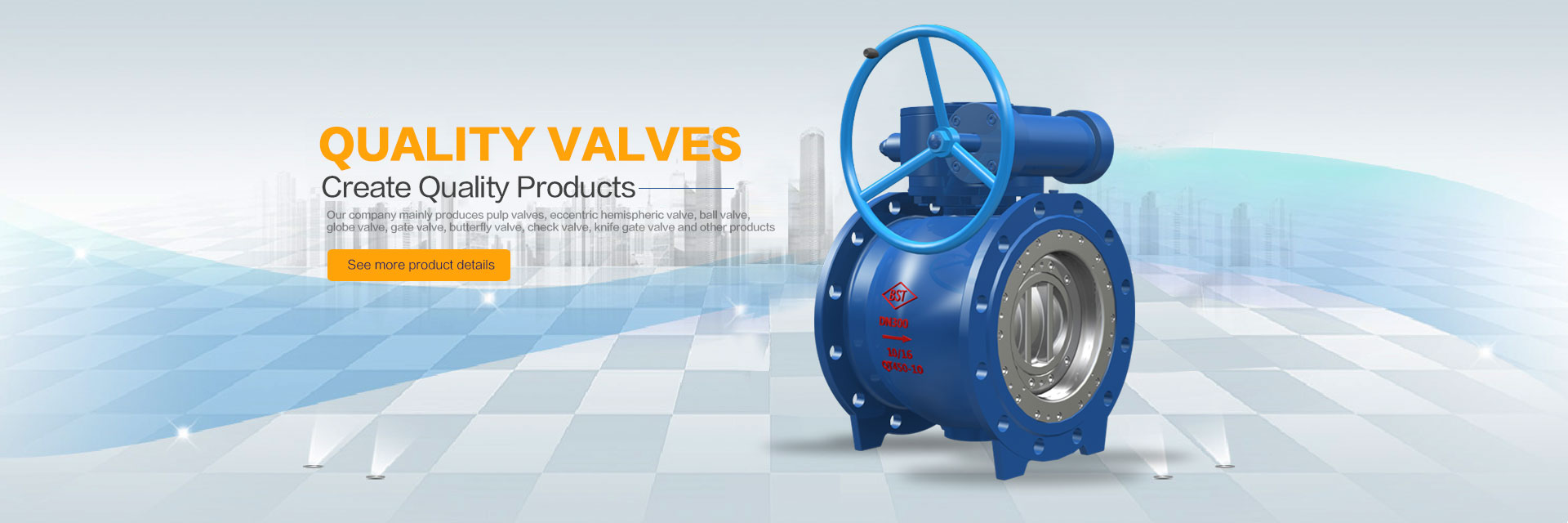The principle, installation and maintenance of pneumatic control valve is enough.
Pneumatic control valve is one of the industrial process control instruments widely used in petroleum, chemical, electric power, metallurgy and other industrial enterprises. Regulating valve in chemical production is indispensable in the regulation system, it is an important part of industrial automation system, such as the production process automation. The following is a comprehensive understanding of the pneumatic control valve.
Working principle
Pneumatic control valve is to use compressed air as the power source, cylinder as the actuator, and with the aid of electrical valve positioner, converter, solenoid valve, retaining valve and other accessories to drive the valve, to achieve switching or proportional regulation, receiving industrial automation control system control signals to complete the regulation of pipeline media: flow, retention valve and other accessories to regulate the valve. Various technological parameters such as pressure and temperature. Pneumatic control valve is characterized by simple control, rapid response, and inherent safety, no need to take additional explosion-proof measures.
Pneumatic control valve is usually composed of pneumatic actuator and control valve connection installation and debugging, pneumatic actuator can be divided into single-acting and double-acting two kinds, single-acting actuator with reset spring, and double-acting actuator without reset spring. The single-acting actuator can be automatically relocated to the opening or closing state set initially by the valve in case of loss of origin or sudden failure.
The pneumatic control valve is divided into two types according to the action form, namely normal open and normal closed. The pneumatic control valve is usually opened or closed by the positive and negative action of the actuator and different assembling methods of the valve structure.
Action mode of pneumatic control valve
Air-open (normally closed) is when the pressure above the diaphragm head increases, the valve moves in the direction of increasing the opening, when the upper limit of the input pressure is reached, the valve is fully open. Conversely, when the air pressure decreases, the valve moves in the direction of closing, and when there is no air input, the valve is completely closed. Normally, we call the gas operated control valve as the fault closed valve.
The gas direction (normally open) action direction is exactly opposite to the gas opening type. When the air pressure increases, the valve moves toward the closed direction; when the air pressure decreases or is not there, the valve opens toward the open direction or until it is fully opened. Generally speaking, we call the gas control valve a malfunction open valve.
The choice of gas opening and closing is based on the safety angle of technological production. When the gas source is cut off, whether the regulating valve is in the closed position is safe or open.
For example, a furnace's combustion control, a regulator installed in a fuel pipe, controls the supply of fuel according to the temperature of the furnace or the temperature of the heated material at the furnace outlet. At this time, it is better to choose the air valve is safer, because once the supply of air stops, the valve in the closed valve than the valve in full open more appropriate. If the gas source is interrupted, the full opening of the fuel valve will result in excessive heat. Another example is a cooling water cooling heat exchanger equipment, heat materials in the heat exchanger and cooling water heat exchange is cooled, regulating valve installed in the cooling water pipe, with the heat exchanged material temperature to control the cooling water volume, in the gas source interruption, the regulating valve should be in the open position more safely, the appropriate choice of AIR-OFF type (FO) regulation. Valve.
Valve positioner
The valve positioner is the main accessory of the control valve. It is used with the pneumatic control valve. It receives the output signal of the regulator, and then controls the pneumatic control valve with its output signal. When the control valve moves, the displacement of the valve stem is fed back to the valve positioner through the mechanical device, and the valve position is transmitted to the upper by the electric signal. Bit system. Valve positioner can be divided into pneumatic valve positioner, electro-pneumatic valve positioner and intelligent valve positioner according to its structure and working principle.
The valve positioner can increase the output power of the regulating valve, reduce the transmission lag of the regulating signal, speed up the moving speed of the valve stem, improve the linearity of the valve, overcome the friction of the valve stem and eliminate the influence of unbalanced force, so as to ensure the correct positioning of the regulating valve.
The actuator is divided into pneumatic actuators and electric actuators, with straight travel and angular stroke. To automatically and manually open and close various kinds of door and wind panels.
Installation principle of pneumatic control valve
(1) Pneumatic control valve installation position, from the ground requirements have a certain height, the upper and lower valves to leave a certain space for valve disassembly and repair. For control valves with pneumatic valve positioners and handwheels, easy operation, observation and adjustment must be ensured.
(2) Regulating valve should be installed on the horizontal pipe, and vertical with the pipe, generally to be supported under the valve to ensure stability and reliability. For special occasions, adjusting valves should be installed horizontally on vertical pipes, and the adjusting valves should also be supported (except small caliber adjusting valves). When installing, avoid additional stress on the control valve.
(3) The working environment temperature of the control valve should be (-30~+60) relative humidity is not more than 95% 95%, relative humidity is not more than 95%.
(4) The front and back position of the control valve should be straight pipe section, length not less than 10 times the pipe diameter (10D), in order to avoid the valve's straight pipe section is too short and affect the flow characteristics.
(5) the diameter of the regulating valve is not the same as that of the process pipe, so the reducer should be connected. When the small caliber control valve is installed, thread connection can be used. The arrow in the fluid direction of the valve body should be consistent with the direction of the fluid.
(6) bypass piping should be set up. The purpose is to facilitate switching or manual operation, and can check the control valve without stopping.
(7) the control valve must thoroughly remove the foreign matter in the pipeline before installation, such as dirt, welding slag and so on.
Common faults and treatment
Control valve does not act.
First, confirm whether the gas pressure is normal and locate the gas source fault. If the pressure of the air source is normal, the output of the amplifier of the locator or the electrical/pneumatic converter is judged; if not, the constant throttle orifice of the amplifier is blocked, or the moisture in the compressed air accumulates at the ball valve of the amplifier. Use small thin steel wire to dredge constant throttle hole, remove dirt or clean gas source.
If all the above are normal, there is a signal and no action, then the actuator failure or stem bending, or valve spool stuck. In this case, the valve must be unloaded for further inspection.
Control valve jam
If the valve stem reciprocating stroke action is slow, then the valve body or viscous material, coke plugging or packing too tight, or PTFE packing aging, stem bending scratches. Most of the control valve blockage faults occur in the new operation system and the early stage of overhaul and commissioning. The blockage caused by welding slag and rust in the pipeline at the throttle and the guiding position makes the medium flow not smooth, or the packing in the overhaul of the control valve is too tight, resulting in increased friction, resulting in small signal inactivity and large signal overaction. Phenomenon.
In such cases, the auxiliary line or control valve can be swiftly opened or closed so that the stolen goods are washed away by the medium from the auxiliary line or control valve. In addition, the valve stem can also be clamped with pipe clamps. Under the condition of additional signal pressure, the valve stem can be rotated forcibly in the opposite direction to allow the valve core to flash through the clamp. If it can not solve the problem, it can increase the pressure of the gas source and increase the driving power to move up and down repeatedly several times, which can solve the problem. If you still can not move, you need to do control valve dismantling, of course, this work requires a strong professional skills, must be completed with the assistance of professional and technical personnel, otherwise the consequences will be more serious.
Valve leakage
Regulating valve leakage generally has the control valve leakage, packing leakage and valve core, valve seat deformation caused by several leakage, the following are analyzed.
1. Valve leakage
The valve stem length is not comfortable, the air valve stem is too long, the stem up (or down) distance is not enough, resulting in a gap between the valve core and the seat, can not fully contact, resulting in lax and internal leakage. Similarly, the valve stem is too short, can also lead to a gap between the valve spool and the seat, can not fully contact, resulting in lax closure and internal leakage. Solution: we should shorten (or extend) the adjusting valve stem so that the length of the regulating valve is suitable, so that it will no longer leak.
2. Packing leakage
After filling the stuffing box, the axial pressure is applied to the gland. Because of the plastic deformation of the packing, it produces radial force and contacts closely with the valve stem, but this contact is not very uniform, some parts contact loosely, some parts contact tightly, and even some parts do not contact at all. During the operation of the regulating valve, there is a relative movement between the stem and the packing, which is called axial movement. In the process of operation, with the influence of high temperature, high pressure and permeable fluid medium, the packing box of regulating valve is also the place where leakage occurs. The main cause of packing leakage is interfacial leakage, which may occur in textile fillers (the pressure medium leaks out along the tiny gap between the filler fibers). The interfacial leakage between the valve stem and the packing is caused by the gradual attenuation of the packing contact pressure and the aging of the packing itself. At this time, the pressure medium will leak out along the contact gap between the packing and the valve stem.
In order to make filler loading convenient, chamfer at the top of the filler box is placed in the bottom of the filler box with a small clearance of erosion-resistant metal protective ring, pay attention to the contact surface between the protective ring and the filler can not be inclined to prevent the filler from being pushed out by the medium pressure. The surface of the contact part between the packing box and the packing should be finished to improve the surface finish and reduce the wear of the packing. Flexible graphite is chosen as filler because of its good air tightness, low friction, small change in long-term use, small wear and tear, easy maintenance, and after the screw cap bolt is tightened again, friction does not change, pressure and heat resistance is good, is not eroded by the internal medium, and the metal contacted with the valve stem and packing box does not occur. Pitting or corrosion. Thus, the sealing of the stem packing box is effectively protected, the reliability of the packing seal is guaranteed, and the service life is greatly improved.
3. Spool and valve seat leakage.
The main reason for the leakage of the valve core and seat is that the casting or forging defects in the production process of the control valve can lead to corrosion strengthening. The erosion of the corrosive medium will cause leakage of the regulating valve. Corrosion mainly exists in the form of erosion or cavitation. When the corrosive medium is passing through the regulating valve, it will produce the erosion and impact on the valve core and seat material, making the valve core and seat oval or other shape. As time goes on, it will lead to the mismatch of the valve core and seat, there are gaps and leaks when the valve is not tightly closed.
Good material selection of valve core and valve seat. Choose corrosion resistant materials, and eliminate products with defects such as pitting and trachoma. If the deformation of valve core and seat is not too serious, fine sand paper can be used to grind, eliminate traces, improve sealing smoothness, to improve sealing performance. If the damage is serious, the new valve should be renewed.
Oscillations
The spring stiffness of the regulating valve is insufficient, the output signal of the regulating valve is unstable and the sharp change is easy to cause the oscillation of the regulating valve. The frequency of the selected valve is the same as that of the system, or the pipe and the base vibrate violently, so that the control valve vibrates accordingly. When the valve is not properly selected, there are drastic variations in flow resistance, velocity and pressure when it works in small opening. When it exceeds the stiffness of the valve, the stability becomes worse and oscillates when it is serious.
There are many reasons for the oscillation. Specific problems should be analyzed in detail. If the vibration is slight, the stiffness can be increased to eliminate, such as choosing the adjusting valve with large stiffness spring and using the piston actuating structure; if the pipe and the base vibrate violently, the vibration disturbance can be eliminated by increasing the support; if the frequency of the valve is the same as that of the system, the adjusting valve with different structure can be replaced; if the vibration is caused by the small opening, the vibration can be eliminated. It is caused by improper type selection, specifically because the valve flow capacity C value is too large, must be re-selected, choose flow capacity C value is small or the use of split control or sub-master valve to overcome the oscillation caused by the operation of the control valve in small opening.
The noise of the regulating valve is large.
When the fluid flows through the control valve, such as the pressure difference between the front and back is too large, cavitation will occur for the valve core, valve seat and other parts, causing the fluid to produce noise. When the value of flow capacity is large, it is necessary to re-select the appropriate value of flow capacity of the regulating valve to overcome the noise caused by the operation of the regulating valve in a small opening. Here are some ways to eliminate noise.
1, eliminate resonance noise method.
Only when the control valve resonates, can there be a superimposed noise of more than 100 dB. Some show strong vibration, little noise, some weak vibration, and noise is very large; some vibration and noise are larger. This noise produces a single tone with a frequency of 3000~7000 Hz. Obviously, with the elimination of resonance, the noise will naturally disappear.
2, eliminate cavitation noise method
Cavitation is the main source of hydrodynamic noise. When cavitation occurs, bubble rupture produces high velocity impact, resulting in strong local turbulence and cavitation noise. This noise has a wide frequency range and produces lattice sounds similar to those made by sandstone in a fluid. Eliminating and reducing cavitation is an effective way to eliminate and reduce noise.
3, using thick wall pipeline method
Thick wall tube is one of the ways of sound path treatment. The use of thin walls can increase noise by 5 dB. Using thick walled tubes can reduce noise by 0~20 dB. The thicker the same diameter wall is, the larger the thickness of the same wall will be, and the better the noise reduction effect will be. For example, when the wall thickness of DN200 pipeline is 6.25, 6.75, 8, 10, 12.5, 15, 18, 20, and 21.5 mm, the noise can be reduced by - 3.5, - 2 (i.e., increased), 0, 3, 6, 8, 11, 13, 14.5 decibels respectively. Of course, the thicker the wall is, the higher the cost will be.
4. Adopt the sound absorption material method.
This is also a more common and effective way to deal with sound path. Sound absorbing material can be used to encamp the noise source and the rear valve line. It must be pointed out that since noise travels over long distances through fluid flow, the effectiveness of noise reduction ends where the sound absorbing material package goes and where thick-walled tubes are used. This method can be applied to cases where the noise is not very high and the pipeline is not very long, because it is a more expensive method.
5. Serial muffler method.
Suitable as an aerodynamic noise attenuation, it can effectively eliminate the noise inside the fluid and suppress the noise level transmitted to the solid boundary layer. This method is most effective and economical for high mass flow rate or high pressure drop ratio. The use of absorption series silencers can significantly reduce noise. However, economic considerations are generally limited to about 25 decibels.
6, sound box method
Sound insulation boxes, houses and buildings are used to isolate the noise sources inside and reduce the noise in the external environment to an acceptable level.
7, series throttling method
When the pressure ratio of the control valve is high (delta P/P1 (> 0.8), the series throttling method is used to distribute the total pressure drop on the fixed throttling element behind the control valve and valve. Such as diffuser and multi hole limit plate, which is the most effective way to reduce noise. In order to obtain the best diffuser efficiency, diffuser must be designed according to the installation of each piece (solid shape, size), so that the valve noise level and diffuser noise level is the same.
8. Choose low noise valve.
The low noise valve slows down gradually according to the fluid flowing through the tortuous flow path (multi-channel, multi-channel) of the spool and seat to avoid supersonic flow at any point in the flow path. There are various forms of low-noise valves with various structures (specially designed for use) when used. When the noise is not very big, the use of low noise sleeve valve, noise can be reduced by 10-20 dB, this is the most economical low noise valve.
Valve positioner failure
The common locator works on the principle of mechanical force balance, that is, the nozzle baffle technology. There are mainly the following types of faults:
(1) Because of the mechanical force balance principle, there are many movable parts, which are susceptible to the influence of temperature and vibration, resulting in the fluctuation of the control valve.
(2) Using nozzle baffle technology, because the nozzle hole is very small, easy to be blocked by dust or unclean gas source, so that the positioner can not work properly;
(3) Adopting the principle of force balance, the spring's elastic coefficient will change in the harsh field, resulting in the non-linearity of the control valve and the quality of control will decline.
(4) Intelligent positioner is composed of microprocessor (CPU), A/D, D/A converter and other components. Its working principle is completely different from that of ordinary positioner. The comparison between the given value and the actual value is purely electric signal, not force balance. Therefore, it can overcome the shortcomings of the conventional positioner's force balance. But when used in emergency parking lots, such as emergency shutoff valves, emergency relief valves, these valves are required to be stationary in a certain position, only when an emergency occurs, it is necessary to act reliably, stay in a certain position for a long time, easy to cause electrical converter out of control and small signal does not operate dangerous situation. In addition. The position sensor potentiometer used for valve is in danger of small signal inactivation and large signal full opening because of its working in the field. Therefore, in order to ensure the reliability and availability of intelligent positioners, they must be tested frequently.









